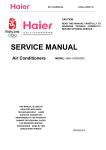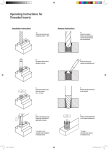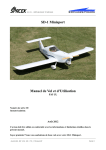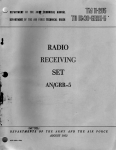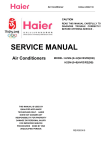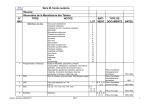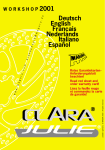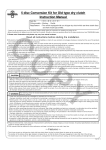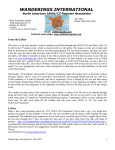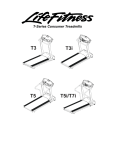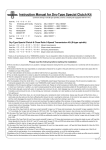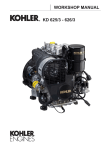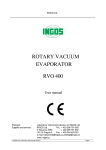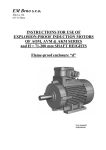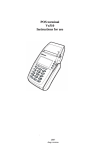Download WORKSHOP MANUAL
Transcript
WORKSHOP MANUAL of Moped BABETTA The Babetta moped is a vehicle of simple design, with minimum maintenance requirements . The workshop manual is mainly intended for workshops carrying out major overhauls . We assume that your workshop is well equipped with standard tools and naturally also with the respective special tools for the Babetta moped . With an adequate stock of genuine spare parts, you will be able to effect all repairs within the shortest possible time and with maximum precision. Through our Service Information Department, you will be informed of any new models and modifications regarding the moped . After Sales Service Povaiske strojarne Manufacturer : Povaiske strojarne, Nat . Corp ., Povazska Bystrica Exporter : 1972 MOTOKOV - PRAHA - CZECHOSLOVAKIA This copy provided free-of-charge by JawaMoped.com for your own personal use. Not to be sold or used for any commercial purpose. Enjoy. Printing Tip:- These pages are A5 size landscape. If you want to print a copy, in printer set-up, set to print full size - multiple page – vertically - 2 to an A4 sheet. JawaMoped.com Page GENERAL INDEX I . General Data 1. 2. 3. 4. 5. Babetta Special Tools Lubrication Chart . List of Bearings and Seal Rings List of Gears . . Transmission layout 4 6 8 10 12 II . Engine 1. 2. 3. 4. Engine - Removing from Frame Engine - Dismantling Carburettor Crankshaft 13 14 18 24 III . Frame 1 . Wheels, Brakes 31 IV. Electrical Equipment 1 . Alternator . 2 . Wiring Diagram 3 . Tranz :mo Unit 2 32 33 35 TECHNICAL DATA Engine type Swept volume Bore x stroke Compression ratio Power output Clutch . . Gearbox Overall transmission ratio Pedals-to-rear-wheel ratio Starting Front suspension Front suspension stroke Brakes Brake dimensions Tyres . Tyre inflation pressure - front - rear Curb weight . Carrying capacity Road speed, steady peak Fuel tank capacity Maximum climbing ability Noise level . . Ignition Spark plug I Ieadlamp Tail light Bell two-stroke, air-cooled, single cylinder 49 c . c. 39 X 41 mm (1 .55 X 1 .61") 1 to 6 .5 1 .5 HP at 4500 RPM automatic, centrifugal, dry One-speed unit 1 : 15 .75 1 : 0 .568 by pedals telescopic fork without damper 60 mm (2 .36") shoe-type drum brakes, operated by handlebar-mounted levers 85 X 20 mm (3 .35 X 0 .79") 23 X 2" 1 .75 atp 2 .25 atp 42 kg (92 .6 lbs) 90 kg (220 lbs) 35 km p . h . (32 m . p . h .) 40 km p . h . (25 . m . p . h .) 3 litres (2 .64 Imp . pt), reserve 0,5 litre (0 .88 pt) 10 73 dB contact-less, semi-conductor PAL 14-512 21W,6V 5 W, 6 V smooth 3 JawaMoped . co m I . GENERAL DATA 1 . Babetta Special Tools Ref. No. Part. No. 1 16-19755-3S-U14 2 Description Purpose Tipping puller (remover) Clutch sealing sleeve removal 975-1100-1 .2 Crankshaft remover (drift) Clutch carrier removal, crankshaft removal 3 928-1200-1 .2 Fitting cartridge Guffero seal fitting 4 50-1200-1 .1 Gudgeon (piston) pin remover (drift) Piston - fitting, removal 5 975-1400-1 .1 Advance feeler gauge Ignition timing 6 928-6000-1 .1 Alternator rotor puller Alternator rotor - removal Fig . 1 4 J awaMoped . co m 2 . Babetta Moped Lubrication Chart Ref. No. 6 Lubrication point Note Lubricant 1 Engine two-stroke engine oil SAE 30 (M 2 T) upper engine lubrication . Oil petrol ratio 1 :30 2- Gearbox gear oil SAE 30-80 (PP80) filling capacity 0 .13 litre 3 Steering bearing grease (AV2) on dismantling, wash and lubricate 4 Twist grip, throttle control lubrication grease (A00) 5 Brake and decompressor levers SAE 30 oil (M6A) 6 Bowden controls light oil fill into bowden casings 7 Wheel hub bearings bearing grease (AV2) top up bearings 8 Brake cam lever pin, brake cams, brake shoe fulcrum pin lubrication grease (A00) after cleaning, provide with a light grease coating 9 Chains graphite grease oil (A00) clean and lubricate, as necessary 10 Stand pin SAE 30 oil (M6A) 11 Pedal bearings SAE 30 oil (M6A) 12 Front fork telescopes SAE 30 oil (M6A) 13 Idling run wheel SAE 30 oil (M6A) after washing, apply to sliding parts Fig . 2 J awaMoped . co m 3 . List of Bearings and Seal Rings Ref . No. Part No. I Description Dimensions (mm) PCs Engine bearings 1 2 3 4 43204 43005 43006 28-2207 43001 Bearing 6203/C3 Bearing 6001/C3 Bearing 6004/C3 Primary transmission needle rollers Wheel hub bearings Bearing 6001 17X 40X 12 12 X 28 X 8 20 X 42 X 12 2 X 12 12 X 28 X 8 2 2 2 26 4 Steering mounting 40001 Ball 5 42 Seal rings (Guffero) 5 6 7 8 9 10 8 50112 50102 50101 50115 50009 50305 Guffero seal Guffero seal Guffero seal Guffero seal Seal ring Seal ring CSN 02 9281 .2 17 X 28 X 28 X 38 X 28 X 30 X 15 X 24 X 25 X 21 0 100 X 7 7 7 7 5 2 1 1 1 1 1 43005 6001/C3 OS 50112 17x28x7 04 28-2207 2x12 • 50112 17x28x7 i € 50102 28x38x7 50101 20x30x7 c 50009 25x21 rl\ 43204 6203 /C3 .10 .m ~O 43006 6004/C3 50305 100x 5 ‚ 50115 P) 15x24x7 Fig . 3 JawaMoped . corn 9 4 . Review of gears Ser. No . Description Number of teeth 1 Gear 20 2 Gear 34 3 Gear 12 4 Gear 36 5 Sprocket 12 Sprocket 39 Fig . 2a Filling and discharging oil screw 1 . Filling hole screw 2. Discharge oil screw 3 . Control hole Pedal transmissions 10 Sprocket 32 Idling sprocket 18 Fig . 4 J awaMoped . co m It 5 . Transmission - Layout 1 .3,25 ,r. I O'0 .1,201 z8.32 1 1 .0,568 I .6.39 MIS x4 .36 M34 I Fig . 5 92 II . ENGINE It should be noted, that elementary maintenance jobs specified in the Driver's Manual, are omitted. 1 . Removing engine from frame a) Remove engine cowlings (see Fig . 6) b) Disconnect the spark plug cable, petrol feed pipe, and throttle control bowden c) Disconnect the electric wiring from the Tranzimo unit d) Disconnect the chain from the primary sprocket (see Fig . 7) e) Disconnect the exhaust pipe from the cylinder f) Free the engine, and pull it clear of the frame (see Fig . 8) Fig. 7 Fig . 6 Fig . 8 J awaMoped . co m 13 Fig. 9 Slackening of clutch securing bolts and flywheel removal The starting clutch plates require no special attention. A point of prime importance His to keep the clutch compartment dry and clean . Pulling off sleeve by means of special service tool No. 16-19755-3S Fig . 11 Fig. 10 14 Pulling off clutch carrier using Babetta special service tool No . 975-1100-1 .2 Prior to removing the clutch drum, be sure to take out Seeger circlip Fig . 12 Pulling seal ring out of clutch drum Fig . 13 Starting clutch removal Do not lose wire clips Fig . 14 JawaMoped . com 15 Cylinder Barrel Removal Fig . 16 Fig . 15 Cylinder Head Removal Removing gudgeon (piston) pin using special service tool Fig. 17 No . 50-1200-1 .1 Maximum permissible gap of a worn piston ring is 0 .5 to 0 .6 mm (0 .002 to 0 .024") . 16 Cylinder Grading Table Diameter X H6 Standard Rebore I Rebore II Reborn III Rebore IV 39 .00+0 .016 39 .25+0 .016 39 .50+0 .016 39 .75+0 .016 40 .00+0 .016 I A 39 .00+0 .006 39 .25+0 .006 39 .50+0 .006 39 .75+0 .006 40 .00+0 .006 B C 39 .006+0 .005 39 .256+0 .005 39 .506+0 .005 39 .756+0 .005 40 .006+0 .005 39.011+0 .005 39 .261+0 .005 39.511+0 .005 39 .761+0 .005 40 .011+0 .005 B C Piston Grading Table Piston Grading A 1 39 .116-0 .006 39.106-0 .006 39 .111 -0 .005 39 .116-0 .005 Rebore II 39 .366-0 .016 39.356-0 .006 39 .361-0.005 39 .365-0 .005 Rebore III 39 .616 -0 .016 39.606 -0.006 39 .611-0.005 39 .616-0 .005 Rebore IV 39 .866-0 .016 39 .856-0 .006 39 .861-0 .005 39 .866-0.005 Rebore J awaMoped . co m 17 3 . CARBURETTOR The Babetta moped is provided with a JIKOV 2909 DC carburettor with the following technical specifications : Main jet Idling jet Throttle needle Fast idling screw 63 35 IInd notch from above 1'/2 turn The basic maintenance of the carburettor comprises dismantling, flushing with clean petrol, and blowing dry with compressed air . Be sure to clean the jet solely with petrol (or acetone) and air . Never use pieces of wire or any other hard items, in order to avoid any hazard of damage to the calibrated holes . In case of a more thorough overhaul of the carburettor, proceed as follows : 1 . Remove the carburettor from the engine, dismantle it, and clean thoroughly the individual components . 2 . Discard any worn parts and replace them with new ones . 3 . Check the flange for level face, and if pitted, true it on a piece of emery cloth placed on a flat surface . 4 . Having reground the carburettor body, clean it again thoroughly . 5 . Check the setting components for compliance with specifications . For checking, use the JSK 3 test station with the respective attachments and scales, as follows : a) For checking the main jet, use the hose attached to the extension marked A-D . Attach the general-purpose holder to scale D . b) When checking the idling jet, proceed in a similar manner, attaching the holder to scale A . c) Check the carburettor throttle for wear with regard to the throttle chamber . The play must not be excessive, otherwise the throttle is likely to vibrate (noisy operation, pinking) . _ 6 . Having reassembled the carburettor, check the needle valve for leakage . Attach the hose of the valve tester to the fuel feed line, and turn the carburettor so as to close the needle valve . The tester must be set to a reading of 0 .4 kg/cm 2 (5.69 psi) . The maximum permissible pressure drop is one graduation, i . e ., 0 .05 kg/cm 2 (0 .71 psi) per 5 seconds . 7 . Adjust the throttle needle and throttle stop screw as per specifications, and finish the assembly procedure . 8 . Install the carburettor in position on the engine . Start the engine, warm it up, and adjust the required mixture richness by means of the air screw. Adjust the idling speed by means of the fast idling screw, and the twist grip play by means of the bowden control . Adjust the throttle stop screw so as to ensure as regular operation of the engine as possible, with smooth transition points between idling and higher speed (RPM) . 1S Fig . 18 JawaMoped . co m 19 Fig. 19 Releasing Alternator Cover Spring and its removing Removing Alternator Rotor Using Special Service Tool No. 16-65672-4 .3 Fig . 20 . 20 Fig . 21 Slackening Alternator Holding Bolt Fitting Guffero Seal 17 X 28 X 7 Using Special Service Tool No . 928-1200-1 .2 Fig . 22 Fig . 23 Removing Alternator Stator Removing L-H Engine (Crankcase) Cover Fig . 24 JawaMoped . co m 21 Fig. 25 Removing Primary Transmission Gear Take care of the needle roller bearing . 26 needle rollers are fitted, the respective dimensions being 2X12 On fitting, grading according to the Table below is to be observed Classing Class Fig . 26 22 0 2-0 .01 Dimension 1 0 2 .000-0 .002 2 0 1 .998-0 .002 3 0 1 .996 -0 .002 4 0 1 .994 -0.002 5 0 1 .992 -0 .002 Pulling Off of Gear Wheel Fitting Gufero Seal in Position in Crankcase Pressed Out Crankshaft c/w RH Crankcase Cover Fig . 27 Fig . 28 Using Special Service Tool No . 928-1200-1 .2 Pressing Out Crankshaft From Crankcase Using Special Service Tool No . 975-1100-1 .2 Pressing Out Crankshaft Fig . 29 JawaMoped . com 23 4 . Crankshaft Dismantling and Reassembly 1 . To dismantle the crankshaft, use a press developing a pressure of approximately 5000 kg (11,023 lbs) . Prior to dismantling, mark the respective position of the crankshaft flywheels by means of check marks (using a square) . 2 . Press out the crankpin first from one crankshaft web, and then_ from the other one . 3 . Renew the connecting rod, crankpin . and cage complete with rollers according to the Grading Table . 4 . Thoroughly clean the crankshaft components, paying particular attention To the journals, which must be perfectly dry . 5 . Press the crankpin home into the flywheel so that its face is just flush with the flywheel outer face . 6 . Install the cage complete with rollers - lubricate with mineral jelly . 7 . Press fit the flywheel according to the check marks previously provided . 8 . After press-fitting, the crankshaft must be centred . Crankshaft Alignment Check the crankshaft for alignment and permissible out-of-round tolerances in a special jig (between centres), using two dial indicators . Clamp the crankshaft between the centres so as to ensure free rotation . The maximum permissible peripheral out-of-true of the functional points is 0 .06 mm (0 .0024") . The shoulders for the bearings are to be considered as functional points . Both the desing of the machine and the respective production technology ensure the tolerance limits specified above . Be sure to check the crankshaft for correct running (alignment) prior to fitting it to the engine . In case of a new crankshaft, misalignment may be due to an accident, careless transport, dropping it on the ground, or possibly reconditioning of the shaft . To ensure correct axial play of the crankshaft in the crankcase, adhere to the specification of 38-0 .2 mm (1 .496-0 .008") regarding the distance between the bearing shoulders after press-fitting . Ensure a correct distance between the flywheels at the point of crankpin, specified to a minimum of 12 .1 mm (0 .476") . Fig. 30 24 ti Crankshaft Alignment Procedure Check axial alignment of the crankpins as per Fig . 30 . If the two crankshaft halves are misalined (out of parallel), take the shaft from between the centres, place it on a suitable pad (copper, aluminium), and using a hammer of soft material or possibly a hand-operated crank press, proceed to align, until thee most correct axial alignment of the crankpins is obtained . The two crankshaft halves are not misaligned . if the readings of the two dial indicators are equal while the shaft turns . After this check (if the respective out-of-true of the functional parts exceeds 0 .06 mm (0 .0024")), aling the centre line of the crankshaft by bending the two shaft halves, as necessary . The procedure can be seen in Fig . 33, Ref . Nos . 2, 3 . According to the respective misalignment of the crankshaft centre line (as per the dial indicator readings), bend the flywheels so as to converge (in case of - - readings), or so as to diverge (in case of + + readings) . If necessary, proceed to align at several levels, not only as shown in the picture . For final alignment, observe the specification 0 .06 mm (0 .0024") regarding the permissible out of true of the functional points . If this method fails to ensure the permissible tolerance limits in the peripheral out of true of the shoulder carrying the drive gear of the primary transmission, the respective half the crankshaft is faulty and must be replaced with a new one or reconditioned by grinding . Since this operation is considered rather exacting, it is advisable to entrust it to skilled craftsmen only. J awaMoped . co m 25 Table of Con-Rod Big End Grading Connecting rod 9 10 8 7 6 C D E Roller I A 9 8 7 6 5 A B C D E 8 7 6 5 A B C D 7 6 A B 6 .7 5 .6 ~ 4 .5 B I C Pin Roller II I Roller III I 5 I 4 IV V I A I C D I babetta 26 I E I 3 I 3 .4 D Pin I Roller I E 2 .3 E Pin Pin Roller I Pin Detail of Engine Drive Release Mechanism Fig . 31 Fig . 32 Removing Control Gear On fitting, be sure to lock the pin in position . Removing drive Gear Fig. 33 The change over switch pin be assembled so the pin grooves are between the change over switch balls . J awaMoped . co m 27 III . FRAME Pedal Transmission - Removal 0 Fig . 35 AI-C. Fig. 34 Removing Drive Gear Shaft When replacing the bearings, it is advisable to warm up the crankcase to approximately 80 €C . MEW A Front Telescope Plug - Removal Fig . 36 ~hIIIII~I IIIIIII~7" 28 Front Telescope Nut - Slackening Fig . 37 Front Telescope Slider (Plunger) Fig . 38 Front Telescope Spring Retainer - Release - Removal Fig . 39 JawaMoped . co m 29 Fig . 40 Front Fork 30 Exploded View c. u .. N a N 0 3 N N E L C7 a € a a ps Q' 3 oio w ,b ,Y .N U € O' (1 C w u N U € G " C 3 d F Front and Rear Wheel J awaMoped . co m Fig . 41 31 IV . ELECTRICAL EQUIPMENT 1 . Alternator Electric current is supplied from a 6-pole alternator of standardized unit design, with ferrite basis . The ignition system proper is contactiess . Instead of contact breaker arm, a trip coil is fitted in the arm of the alternator stator . Individual alternator circuits : First circuit : Ignition feed pole, and primary (path indicator) coil of contact breaker Second circuit : Headlamp and tail light feed pole Bulbs : One PS 25-1, 6 V/21 W Ba 15s One C 11, 6 V/5 W, SV 8 .5 32 Babetta Alternator JawaMoped. com Fig . 42 33 L. € 6 € ' TRANZIMO Cable : black green red . white yellow 1 . Alternator . 2 . Tranzimo unit . 3. Sparking plug with cable shoe . 4 . Tail lamp . 7. Headlamp 2 . Babetta Moped - Electric Wiring Diagram 34 Fig, 43 3 . Tranzimo Unit MS-50 Moped Ignition Circuit - Checking Procedure 1 . Check the spark length on a standardized three-electrode spark gap ; on starting. a flashover of 6 mm (0 .23b") must occur . (Turn the engine with the spark plug screwed in) . If the spark length is satisfactory, check the spark plug, or possibly the cable shoe . If these components are sound, the fault is to be traced outside the ignition system . 2 . If the spark length is unsatisfactory, or if misfiring takes place, check the following points : a) Sound condition of the ,TRANZIMO" rear cap - if the cap is defective, replace it with a new one and clean the area round the transistor . b) Correct connection of the individual conductors to the semi-conductor part of the TRANZIMO unit as per the Wiring Diagram . c) Perfect connection in the connectors . 3 . If the fault persists, check the semi-conductor TRANZIMO part for sound condition, by connecting a tested TRANZIMO unit to the connecting wires . If the spark is now satisfactory, the defect is due to the semi-conductor part . If the fault still continues, the alternator is faulty . 4 . In the alternator compartment, check whether the wires are properly soldered to the coil ends, or if they are not mechanically damaged . In addition, check the air gap between the rotor and pole shoes . (0 .3 mm, i . e . 0 .012") . If no defect of this sort is found, or if rectification of the respective defect has not helped, measure the feed voltage as follows : Disconnect the red wire from the TRANZIMO unit, charge the 4 ,tF (600 V capacitor via the KY705 diode, and check the capacitor voltage by means of the Avomet-II . (DUIO) measuring unit . At 600 RPM of the engine, i . e ., starting speed of the engine, a voltage of approximately 40 V must be ascertained . If the voltage is below this specification, or no voltage can be measured, the feed (induction) coil must be replaced by a new one . If the voltage of the feed (induction) coil is correct, check the voltage of the pulseforming coil in the same manner (white wire) - within a range of 3 V, the respective voltage must attain approximately 0 .3 V. If no voltage can be measured, the entire stator frame with riveted-on starting coil must be replaced by new one . 5 . The semi-conductor part of the TRANZIMO unit can be repaired only if the fault is due to the transistor itself - this can be ascertained by replacing the transistor with a new one. Interchanging of the wires soldered to the transistor may result in deterioration of the transistor . More over, care must be taken not to overheat unduly the transistor terminals on soldering . Published by After - Sale Service Department ., Pova2ske stroiarne . Povazska Bystrica - CSSR . DTP 2963-71 35 JawaMoped . co m




































